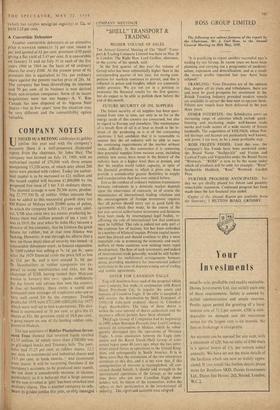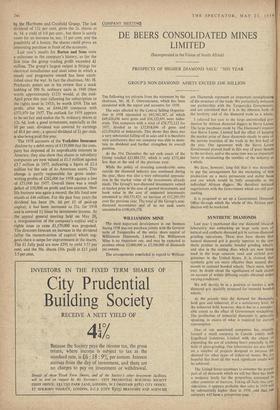COMPANY NOTES
UNITED SUA BETONG celebrates its golden jubilee this year and with the company's accounts there is a well-presented illustrated 'sport from the chairman, Sir John Hay. The :ompany was formed on July 19, 1909, with an authorised capital of £70,000 with three estates comprising 13,320 acres, of which only about 200 acres were planted with rubber. Today the author- ised capital is to be increased to £2.1 million and the issued capital will become £1,800,000 by the proposed free issue of I for 3 £1 ordinary shares, The planted acreage is now 20,306 acres, produc- ing 22,777,500 lb. of rubber. Other interests that zan be added to this successful growth story are Oil Palms of Malaya with 20,000 acres of palms, in which the company holds a 3IA per cent. inter- est. USB also owns two tea estates producing be- tween them two million pounds of tea a year. It was in 1919, the year when Sir John Hay became a director of the company, that he foresaw the great future for rubber, but at that time finance was lacking. However, it was through his efforts that a new (in those days) class of security was issued—a convertible debenture stock, to finance expansion. In 1909' rubber was selling at 7s. Id. per lb.; soon after the 1929 financial crisis the price fell as low as I :d. per lb., and is now around 2s. 6d. per lb. Shareholders in rubber companies are ex- Posed to many uncertainties and risks, but the chairman of USB, having visited their Malayan estates in January this year, speaks confidently for the future and advises that now the country Is free of banditry, there exists a sound and contented state amongst all employees who are so very well . cared for by the company. Trading profits for 1958 were £713,000 (£842.000 for 1957) Which were well up to best expectations. The divi- dend is maintained at 50 per cent. to give the £1 shares at 92s. the generous yield of 10.8 per cent., a good return on one of the leading rubber com- Panies in Malaya.
The last accounts of Rubber Plantations Invest- ment Trust showed that invested funds totalled £2.33 million, of which More than £700,000 was in gilt-edged stocks and Treasury bills. The port- folio had 37.25 per cent. in rubber shares, 12.5 per cent. in commercial and industrial shares and 15.5 per cent, in bank insurat.:- and investment trust shares. It will be surprising therefore if the company's accounts, to be produced next month, do not show a considerable increase in income, particularly as it is believed that a large amount of the sum invested in 'gilts' has been switched into ordinary shares. This is another company to cele- brate its golden jubilee this year, so ably managed
by the Harrlsons and Crosfield Group. The last dividend of 12+ per cent. gives the 2s. shares at 4s. 3d. a yield of 6.0 per cent., but there is surely room for an increase to, say, 15 per cent. and the possibility of a bonus; the shares could prove an interesting purchase in front of the accounts.
Last year's results for Barton and Sons were a milestone in the company's history, as for the first time the group trading profit exceeded £1 million. The group's largest output is fittings for electrical installations and steel tubes in which a steady • and progressive record has been estab- lished since the war. In fact the chairman, Mr. H. Prichards, points out in his review that a stock holding of 500 5s. ordinary units in 1948 (then worth approximately £123) would, at the mid- April price this year (allowing for subscription to the rights issue in 1953), be worth £918. The net profit, after tax, at £444,189 compares with £373,979 for 1957. The outlook for 1959 appears to be set fair and makes the 5s. ordinary shares at 12s. 6d. look a good investment, especially as the 10 per cent. dividend was covered by earnings of 40.8 per cent.; a special dividend of 21 per cent. is also being paid this year.
The 1958 accounts of the Yorkshire Insurance disclose by a debit entry of £129,000 that the com- pany has disposed of its unprofitable interests in America; they also show that shares in subsidiary companies are now valued at £1.3 million against £3.7 million in 1957, indicating a figure of £2.4 million for the sale of its American assets. This change is partly responsible for gross under- writing profits of £262,000 for 1958 against a loss of £73,000 for 1957. Overall there was a small deficit of £18,000 on profit and loss account. New life business was again a record; the life fund now stands at £46 million. For the past four years the dividend has been 19s. 6d. per £1 of paid-up capital; it has been increased to 21s. for 1958 and is covered 1+ times by investment income. At the annual general meeting held on May 20, a reorganisation of the company's capital and a rights issue to raise £1,170,000 was proposed. The directors forecast an increase in the dividend (after the reconstruction of capital) which sug- gests there is scope for improvement in the shares. The £1 fully paid are now £29+ to yield 3,55 per cent. and the 50s. shares (10s. paid) at £15 yield 3.5 per cent.







































 Previous page
Previous page